Originally published on August 20, 2012
Review and photos by Jonathan Yarkony
Photo Gallery:
2012 Fuel Efficient Cars Comparo
2012 Chevrolet Volt (range-extended electric car)
2012 Hyundai Sonata Hybrid (Li-ion battery)
2013 Mazda CX-5 (SkyActiv-G)
2012 Toyota Prius (Hybrid, NiMH battery)
2012 Volkswagen Golf TDI (Clean Diesel)
This is a different kind of comparison.
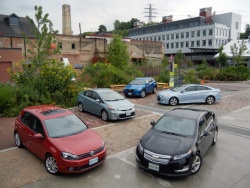 The Contenders: Golf TDI, Prius, CX-5, Sonata Hybrid, and Volt at Evergreen Brickworks. Click image to enlarge |
These are not competitors in the strictest sense of the word. However, some compete in very hot segments, while others are essentially competing for the attention of thrifty drivers with a variety of needs. We excluded full electric vehicles because we wanted to focus on vehicles that we think can serve as the only vehicle for a single-car household.
The Prius needs no introduction, having brought look-at-me-I’m-green styling and efficient hybrid motoring to the masses. The Chevy Volt’s hype machine isn’t far behind in advertising its revolutionary drivetrain—essentially an electric car with an onboard generator to charge the battery. We even brought a second hybrid, the Hyundai Sonata Hybrid, which doubles as an ordinary family sedan—okay, the styling is far from ordinary—and we chose it to see if the advantages of its Lithium-ion battery lived up to the billing. We even brought a couple vehicles with conventional drivetrains, the Mazda CX-5 compact crossover with a gasoline internal combustion engine, and a compact hatchback Volkswagen Golf TDI that uses a turbocharged compression-ignition diesel, an incredibly popular choice in Europe, though still rare on our shores.
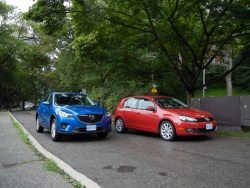 Golf TDI Diesel and CX-5 SkyActiv-Gasoline. Click image to enlarge |
In this comparison, we’ll explain how each technology works to save gas, as well as assess their more ordinary qualities like value and performance.
I am torn between claiming that these are all winners or that we are the true winners, with access to a variety of interesting and appealing cars that prove that driving efficiently doesn’t have to be a punishment. But both are tired clichés, so I’ll just move on to the real reason we assembled these cars: curiosity. Sure, AJAC organized an elaborate Eco-Run event that included many of these same vehicles to demonstrate the variety and range of various efficiency technologies, but we wanted to get our hands on some of these vehicles, drive them to and from work ourselves in more normal conditions and report on their real-world performance, both in terms of efficiency and as daily drivers.
2013 Mazda CX-5
NRCan Fuel Consumption Estimate: 7.7/6.1 L/100 km city/highway
US EPA Fuel Consumption Estimate: 9.0/6.1/8.1 L/100 km city/highway/combined
Observed Real-World Consumption: 7.3 L/100 km (500+ km, commuting and long-distance highway)
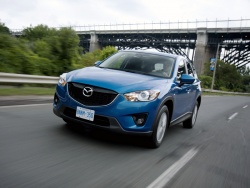 2013 Mazda CX-5, photo by JC. Click image to enlarge |
As expected, the most conventional vehicle here had the highest fuel consumption, although we were pleasantly surprised by just how close the 2013 Mazda CX-5 came to matching the larger of the two hybrids in test. It delivered an impressive 7.3 L/100 km in over 500 km of commuting in this test and even showed 6.4 on one long-distance highway drive, not to mention Mike’s 5.6 on the AJAC Eco-Run this past spring, and after proving itself over 1.0 L/100 km better than the next best in our Compact CUV Comparison Test.
In this company, the CX-5 seems large, but as most cars go, it is a very manageable size, with impressive rear seat and cargo space (966 L trunk, 1,852 L seats folded), not to mention handy seat-dropping levers in the trunk area.
The reason for its inclusion isn’t its practicality, but the effort Mazda invested to make the most of the gasoline internal combustion engine through their SkyActiv program. Don’t worry, this technology will not take over our entire electronic infrastructure to induce a global thermonuclear war to that autonomous machines can take over the planet. However, SkyActiv isn’t just an engine technology, it is a complete vehicle philosophy to get the most efficiency and driving pleasure out of any given vehicle. The 2013 CX-5 is the first vehicle to be designed under the SkyActiv program from the ground up, platform, suspension, and powertrain.
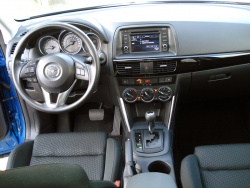 2013 Mazda CX-5, photo by Mike Schlee. Click image to enlarge |
Of course, the powertrain is the most significant piece of the fuel efficiency puzzle, and the CX-5 uses a 2.0L SkyActiv-G(asoline) inline-four-cylinder engine that yields 155 hp and 150 lb-ft of torque, which is admittedly underwhelming in this 1,488-kg vehicle (1,459 with a manual transmission). The key innovations in achieving the efficiency gains are: a ‘sky’ high compression ratio of 13.0:1, direct injection, and unique piston cavities that improve combustion efficiency (more gasoline burns more completely with every stroke); 4-2-1 exhaust helps waste gases escape more cleanly and reduces backpressure; and weight and friction reductions help make every moving part work more easily.
Meanwhile, the automatic transmission features six gears and combines the clutch of a manual transmission with the torque converter and intelligent shift logic of an automatic in order to borrow the efficiency and connected feel of manual transmissions with the do-it-for-me ease of use of an automatic. The transmission is also painstakingly designed to lose weight and size for more efficient packaging, and it delivers everything Mazda promises, with incredibly smooth yet responsive shifting under any conditions. The manual transmission, as tested in the Mazda3 Sky and in the CX-5 by Chris Chase, is equally adept, with efficiency matched to short throws and tight action for the best of both worlds.
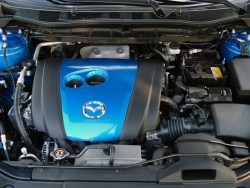 2013 Mazda CX-5, photo by Mike Schlee. Click image to enlarge |
The body itself achieved 8 percent weight loss and 30 percent rigidity after going through the SkyActiv diet, and is easily the lightest of the bestselling crossovers in its class (CR-V, RAV4, Equinox).
The CX-5 is also good value, coming in as cheapest in test at $30,040 (destination and A/C tax rolled in), with impressive features like blind spot monitoring system, backup camera, auto headlights, 17-inch alloys, power moonroof, heated seats, six-way power driver’s seat and standard Bluetooth hands-free phone and streaming audio.
All around, a great package that is still a pleasure to drive with loads of family practicality in this day and age of fewer and fewer wagon options, and real-world fuel economy that has repeatedly proven a clearcut leader amongst any of its internal combustion gasoline counterparts.
Pricing: 2013 Mazda CX-5 GS FWD Automatic
Base price: $28,045
Options: None
Destination: $1,895
A/C Tax: $100
Price as tested: $30,040
2012 Hyundai Sonata Hybrid
NRCan Fuel Consumption Estimate: 5.5/4.6 L/100 km city/highway
US EPA Fuel Consumption Estimate: 6.7/5.9/6.4 L/100 km city/highway/combined
Observed Real-World Consumption: 7.2 L/100 km (400+ km city/highway)
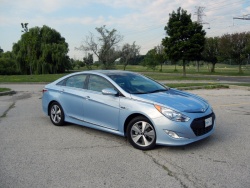 2012 Hyundai Sonata Hybrid. Click image to enlarge |
As mentioned earlier, we wanted to bring one example of a hybrid that you might not even recognize as a hybrid and the Hyundai Sonata Hybrid fits that bill, with Hyundai’s ‘Fluidic Sculpture’ design philosophy shaping its sleek sheet metal. On the other hand, Hyundai’s value philosophy means it is also affordable at $28,999 with power seats, Bluetooth, proximity entry and push-button start, dual-zone auto climate control, leather seats, and a stylish interior to go along with its daring looks.
A Premium package takes the price up to $33,999, adding luxury-brand fare like heated rear seats, panoramic sunroof, backup camera, navigation system with high-res touchscreen and voice activation to go along with the seven-speaker Infinity premium sound system. Destination fees and A/C tax take the as-tested price to $35,664. However, I found headroom in the front seats limited with the sunroof, and the seat did awful things to my back—I just could not find a comfortable position.
The battery itself is constructed of a Lithium polymer, capable of 34 kW of power output with 5.3 Amp-hours of storage capacity. The 30-kW electric motor is rated at 40 hp and 151 lb-ft of torque, that torque is conveniently available from 0–1400 rpm.
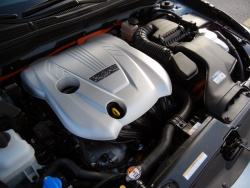 2012 Hyundai Sonata Hybrid. Click image to enlarge |
What advantages does Lithium construction offer? Higher energy density, which means it takes less battery to store an equivalent amount of energy, therefore taking up less space and using less weight than Nickel-Metal Hydride (NiMH) batteries. The Sonata Hybrid’s battery weighs 43.5 kg to the Prius’ 53.3 kg. Other advantages of Lithium-ion batteries are that they operate better in low temperatures, can use more of their capacity, and have more rapid charge times, which is a big issue with fully electric vehicles, but also offers benefits for hybrids. The downsides? They are currently more expensive to produce and may not be as durable over time as NiMH, especially in hot climates.
Despite the high-tech battery, if there was one car that disappointed, both in its efficiency and as an overall driving experience, it was the Sonata Hybrid. Hyundai has received its fair share of flak recently over surprisingly high real-world fuel consumption, and this Sonata Hybrid is no exception. While 7.2 L/100 km is impressive for a heavily featured mid-size sedan (and almost beat a Scion iQ we drove to 7.1 L/100 km recently—mostly highway driving, too), it is so far off the NRCan estimate of 5.5/4.6/5.1 L/100 km city/highway/combined, that it is a bit of a head scratcher. But perhaps more telling is that the Toyota Camry Hybrid, its chief competitor among hybrid family sedans, achieved a 5.7 L/100 km in similar use recently, and not nearly as far removed from its 4.7/5.1 NRCan estimate.
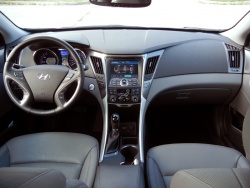 2012 Hyundai Sonata Hybrid. Click image to enlarge |
A shame, too, because many prospective customers that will be drawn to its sophisticated looks, luxurious interior, and long list of standard features will be able to ignore its clunky ride and uneven driving experience. We, however, could not. Whether taking off in electric vehicle (EV) mode on battery power alone, or engaging the engine from a heavy-footed start, the Sonata had uneven power delivery to go along with its unsorted ride and loose, uneven steering. Quite possibly the six-speed automatic was confused by the dual power sources.
However, once at speed, most of the hesitancy smoothed out, and the Lithium-ion battery was eager to take over full responsibility for moving this 1,641-kg sedan along. Come to think of it, the electric bits also did a great job moving the car from a stop without waking up the 166-hp 2.4L gas engine until the battery was near drained, and one doesn’t have to baby the throttle in order to keep it in EV mode. Just put your foot down moderately, as most of us normally do, and you’ll easily lurch up to 40–50 km/h in EV mode.
In the end, it’s a car you’ll pick for style and content, and to gain power while saving gas over other Sonata models, rather than to beat any fuel consumption records.
Price: 2012 Hyundai Sonata Hybrid
Base price: $28,999
Options: $5,000 (Premium Package: heated rear seats, panoramic sunroof, navigation system with high-res touchscreen and voice activation, backup camera, seven-speaker Infinity premium sound system, 17-inch wheels)
Destination: $1,565
A/C Tax: $100
Price as tested: $35,664
2012 Volkswagen Golf TDI
NRCan Fuel Consumption Estimate: 6.7/4.7 L/100 km city/highway
US EPA Fuel Consumption Estimate: 7.8/5.6/6.9 L/100 km city/highway/combined
Observed Real-World Consumption: 6.1 L/100 km (over 1,000 km commuting and long-distance highway)
Although we have long been fans of torquey, fuel efficient diesel powertrains, we had a chance to wow a few colleagues with the Volkswagen Golf TDI’s combination of driving dynamics and efficiency. Anyone who drove it wanted to keep it. Because of its popularity, we racked up over 1,000 km, much of it at very high cruising speeds, and it still kept overall consumption in check at 6.1 L/100 km, though one long-distance highway run clocked a 5.1 L/100 km, within spitting distance of its NRCan estimates of 6.7 L/100 km city, 4.7 L/100 km highway.
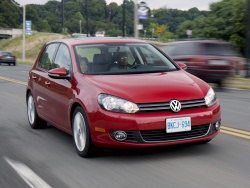 2012 Volkswagen Golf TDI, photo by JC. Click image to enlarge |
The reason everyone wanted to drive it was its quick, light steering, excellent acceleration punch and rewarding dynamics. It’s not a GTI, but it still has that same rock solid chassis and an everyday drivability that includes joy as part of the experience.
While Volkswagen’s diesel engine is unique in the North American compact segment, diesels account for about half the vehicle sales in Europe, are available in a growing number of premium brands here, and some analysts predict that diesel sales in North America will explode, reaching as high as 12 percent market share by 2018, up from the current 3 percent. As gas prices rise, so will sales of diesels, and Volkswagen has a lock on the market as the diesel brand.
What can you expect from a modern clean diesel? Awesome torque, for starters. And while diesels have come a long way in recent years, there is still a low-rpm grumble and coarseness that is never entirely banished, although it is something that many turbocharged gasoline direct-injection engines also exhibit. Of course, diesels are the forerunners that have paved the way for many of the current crop of technologies being applied to gasoline engines, like direct fuel injection, turbocharging, and high compression ratio.
Unlike gasoline engines, in which a spark plug initiates combustion, diesel engines compress the air to such a volatile pressure that simply spraying the fuel into the cylinder is enough to set off the combustion reaction—the Golf TDI reaches a compression ratio of 16.5:1. In order to burn more evenly, diesels have been engineered to spray the fuel more finely using direct injection (that can spray fuel at incredibly high pressure) and using turbos to force even more air into the cylinder for better, more complete combustion—the reason for their greater efficiency.
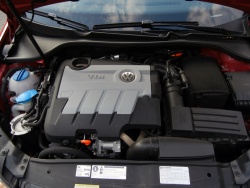 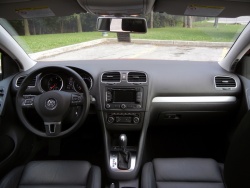 2012 Volkswagen Golf TDI. Click image to enlarge |
Why do diesels produce more torque? In order to reach those higher compression ratios, the piston stroke is longer, so there is more leverage on the crankshaft, turning the crank with greater torque, and conveniently at lower rpms.
Volkswagen offers their diesels in four sizes: small, medium, large, and extra large. The small Golf, medium Jetta and Golf Wagon, and large Passat all use the same 2.0L turbocharged direct injection inline-four making 140 hp @ 4,000 rpm and 236 lb-ft of torque at 1,750–2,500 rpm. The XL Touareg gets a V6 turbodiesel at 225 hp and 406 lb-ft at 1,750–2,250 rpm. The 2.0L TDI, as in the Golf TDI Highline we drove, is available with a six-speed manual transmission or six-speed Direct Sequential Gearbox, an automated manual.
One common complaint about TDIs is that the diesel engine is only available on higher-trim models, meaning the price starts in the $25K neighbourhood. The cheapest TDI you can get into is the Jetta Comfortline TDI with six-speed manual at $23,875 (then add freight and taxes), and the price of entry for a Golf TDI is $25,425. Our Golf TDI Highline DSG came in at $33,150 as tested, but there is no denying it featured suitable levels of equipment to justify that price, not to mention the traditional VW build and materials quality that you will not find on the Jetta or even Passat.
About the only criticism we had was that it can take some trial and error to find gas stations with diesel pumps, and being a compact, it is not the most spacious backseat, but well within norms for the compact class. As we said earlier, everyone who drove it wanted to keep it, including me. Long-Term Test, anyone?
Price: 2012 Volkswagen Golf TDI Highline DSG
Base price: $30,795
Options: $890 (Navigation)
Destination: $1,365
A/C Tax: $100
Price as tested: $33,150
2012 Toyota Prius
NRCan Fuel Consumption Estimate: 3.7/4.0 L/100 km city/highway
US EPA Fuel Consumption Estimate: 4.6/4.9/4.7 L/100 km city/highway/combined
Observed Real-World Consumption: 5.0 L/100 km (400+ km city/highway)
The Toyota Prius didn’t become the global ‘face’ of hybrids just because it looks weird. It delivers exactly what it promises—incredibly low fuel consumption, even in the most demanding driving conditions.
As has been reported by many owners I’ve questioned, 5.0 L/100 km is an entirely realistic combined fuel economy figure, and that is exactly what we achieved in a week of commuting on one of the world’s worst stretches of stop-and-go highway traffic: the 401 through the GTA.
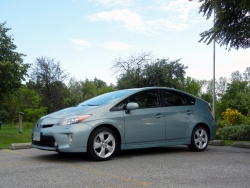 2012 Toyota Prius. Click image to enlarge |
While the Prius delivers the fuel efficiency goods, it does take some adjustments to drive it smoothly. As with most hybrids (and now in many non-hybrids), free electrons are collected from the brake rotors in order to recharge the battery. It is not a significant amount of braking force, but you can feel a slight tug as soon as you get off the gas. And when you add brake pedal pressure, it comes to a stop in sudden, jarring fashion until you get used to it.
The battery powering the Prius’ 60-kW electric motor (80 hp) is a Nickel Metal Hydride (NiMH) battery pack providing 27 kW output at 201.6 volts. The chief advantages of NiMH batteries are their proven stability and affordability—they cost far less to produce in the sizes needed for automotive application than Li-ion. However, NiMH batteries are, on average, heavier for equivalent power storage than Li-ion.
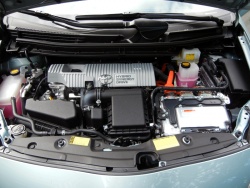 2012 Toyota Prius. Click image to enlarge |
Acceleration is slow and smooth in the Prius and it is almost impossible to tell when the 1.8L gas engines fires up and when it switches back to electric power. The direct-injection engine contributes 98 hp and 105 lb-ft of torque to the cause, and the combined gas-engine/electric motor output is rated at 134 hp, routed to the front wheels through a CVT transmission. You can get a bit more oomph in a driver selectable Power mode, but really, just accept the slowness, try to keep it in EV mode as long as possible, and drive at its pace—that will also yield the best fuel economy. It can cruise comfortably at 120 km/h, although the small engine is a bit whiny at that speed, and everything just seems more natural and comfortable at 100–110 in this car.
Many complain that the Prius handles no better than an average shopping cart, but I think it handles credibly for its purpose. I never even contemplated exploring its limits, and don’t really care how soon it understeers or whether it is vague when pushed beyond speed limits around onramps. I highly doubt most owners would either.
It is stable, quiet, and comfortable on the highway, but excels in tight confines, where its compact footprint and light, quick steering make it an excellent city car. It is also a cinch to park, except for the weird split rear window because of the aerodynamic liftback design. Thankfully, the Prius comes with a standard backup camera, so that’s a wash.
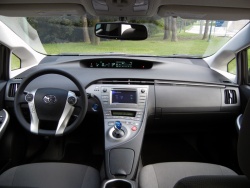 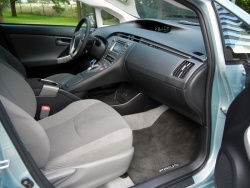 2012 Toyota Prius. Click image to enlarge |
Other standard features on a base Prius ($25,995 MSRP) are Bluetooth phone connectivity, USB jack, keyless entry with push-button start, auto climate control, and cargo capacity of 445 L with 60/40 slip folding rear seats for more flexible space. One surprise we noted was that the Prius handled a six-foot ladder with more room to spare for the front-seat passenger than the CX-5. Our $31,220 Prius Touring included a nav system, satellite radio, fog lamps, 17-inch alloy wheels, LED headlamps, and extended Bluetooth adding phonebook and streaming audio.
If there was one thing we would improve, it is the interior materials. While the Prius is pioneering Eco-plastic—plastics derived from plants—those are not the reason for acres of tinny, tacky plastic everywhere; those are just cheap materials to offset the cost of the advanced powertrain. Some drivers also found the central gauges disorienting and difficult to adapt to, but that might just be the adjustment period—I found them highly visible and clear.
The Prius doesn’t need any defenders; it sells both as a practical, efficient compact car, and as a rolling symbol of energy efficiency and clean emissions. And while some drivers might never be able to give up their desire for an involving driving experience, the Prius entertains with its own unique brand of eco-accomplishment rewards that engages the mind more than the seat of your pants.
Price: 2012 Toyota Prius
Base price: $25,995
Options: $3,555 (Touring Package: navigation, satellite radio, integrated garage door opener, fog lamps, 17-inch alloy wheels, auto-levelling LED headlamps, headlamp washers, passenger door handle touch sensor lock/unlock, and extended Bluetooth adding phonebook and streaming audio)
Freight & PDI: $1,565
A/C Tax: $100
Price as tested: $31,220
2012 Chevrolet Volt
NRCan Fuel Consumption Estimate: Gasoline only 6.7/5.9 L/100 km city/highway; Electric 2.5/2.5 Le/100 km or 22.3 kWh/100 km city/highway
US EPA Fuel Consumption Estimate: Gasoline only 6.7/5.9/6.4 L/100 km city/highway/combined; Electric 2.5 Le/100 km or 22.3 kWh/100 km combined
Observed Real-World’ Consumption: 0.8 L/100 km (exactly 400 km city/highway)
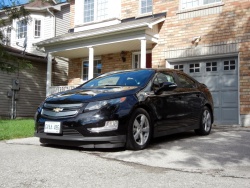 2012 Chevrolet Volt. Click image to enlarge |
The Volt.
This space isn’t nearly enough to really do the Volt justice. But first and foremost it is a good car. I would rather drive this car than any other vehicle in this test— except for the spritely Golf—just for the way it accelerates, turns, and stops. It also looks good, splitting the difference between the aerodynamic-at-all-costs Prius and an ordinary yet edgy sedan.
It picks up speed quickly with the mountains of torque from GM’s revolutionary “Voltec” electric drive unit that houses two electric motors, three clutches, a gear set, and a rainbow-powered unicorn. Well, everything except the rainbow-powered unicorn. The Voltec (it’s kind of fun to say, right? Too bad Voltron was already taken, though…) drive motor can generate 111 kW of motoring power, equivalent to 150 horsepower, plenty for a 1,715-kg car, almost 200 of that the battery. Anyhow, Voltec also pumps out an impressive 273 lb-ft of torque, which gets the Volt moving off the line with a peppy kick.
The Lithium-ion battery itself is described as a rechargeable energy storage system comprising multiple linked modules. Sounds fancy, right? Well, it is also cased in a “T-shaped glass-filled polyester structural composite with aluminum thermal radiation shield and steel.” That’s what keeps the Li-ion battery safe; a US National Highway Traffic Safety Administration (NHTSA) investigation concluded that no defects exist and that it is not a safety concern, despite the inherent risks for Li-ion battery chemical instability that can lead to combustion. It’s safe. Move along folks, nothing to see here.
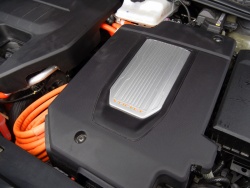 2012 Chevrolet Volt. Click image to enlarge |
Practically, it can cover between 40 and 80 kilometres using no gasoline in pure electric mode, while producing zero tailpipe emissions—the only emissions come from whatever powerplant supplies your home’s electricity, none if you run on wind, sunbeams, or universal good will. It has a 16 kWh charge capacity and takes about 10 to 12 hours to charge from empty at an ordinary 110V household outlet, or about 4 hours with a ‘Stage 2’ 240V charger.
Its ace in the hole is a 1.4L gasoline engine that kicks in as a generator to charge the battery on the fly when the battery is depleted. It extends the range of this ‘electric vehicle’ to a road-trip worthy 500 km or so. In our week with the Volt, we used a total of 3.2 L of gas, in exactly 400 km of city and highway driving, for an average of 0.8 L/100 km. Amazing, right? Well… yes, but I have to confess that we babied the Volt and sent other vehicles on any trips we knew would surpass its range, moreso to prove the point that if your round-trip commute to work is between 50 and 60 km, you could bring your gas bill practically down to dollars per month, with an estimated $50 increase in monthly electricity bill, as per the Energuide estimated annual electrical cost. Of course, rates may vary.
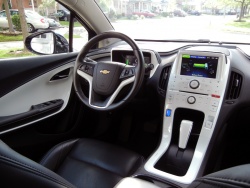 2012 Chevrolet Volt. Click image to enlarge |
However, you will pay rather dearly for this four-seat (yup, count ‘em, just 4) hatchback that cannot match most compact hatchbacks or crossovers for practicality. Starting price is $41,545, and with the Preferred Equipment Group 1SA (sexy package name, GM), Rear Vision Camera and Park Assist Package (gee I wonder what you get with that package?), plus destination and A/C tax, it is the most expensive in test at $45,585. Purchase rebates in Ontario ($8,231), BC ($5,000), and Quebec ($7,769 for 2012; $7,884 for 2013), also available proportionally for shorter term vehicle leases, bring the pricing closer to some of the fully loaded models in this test.
Will you ever make it back in fuel savings? Let’s hope not, because that would probably mean $4.00/L gasoline. As with any advanced technology, you are footing the bill for the research and indirectly investing in further development of alternative propulsion technologies, but you do at least come home with a gee-whiz amazing car.
It is well featured for that price, and I am a big fan of the two-tone white on black interior with glossy white plastic and smooth surface centre stack with touch sensitive points for climate, radio, and vehicle info. The graphics and sound effects for the vehicle interface were also sci-fi cool, and even the whirr of the electric motor under acceleration made for a futuristic soundtrack that reminded you, at every turn that you were driving the future. Just try to put a price on that…
Price: 2012 Chevrolet Volt
Base price: $41,545
Options: $2,490 (Preferred Equipment Group 1SA $1,695; Rear camera and Park assist $795)
Destination: $100
A/C Tax: $1,450
Price as tested: $45,585
Although we implied that there would be no winners, we lied. Though we could hand out participation awards like ‘Most Stylish’ for the Sonata or ‘Most Practical’ for the Mazda CX-5 or ‘Best Hybrid’ for the Prius, this isn’t a yearbook and there were two very clear-cut winners in the two criteria we set out to test.
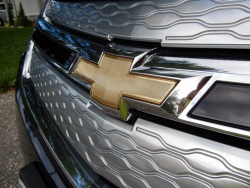 2012 Chevrolet Volt. Click image to enlarge |
Being an automotive site, we have to recognize the Volkswagen Golf TDI as the best ‘driver’s car’ while still delivering excellent fuel economy—it is just plain fun to drive, though perhaps that is relative to the others in this Comparison Test. A Mazda3 SkyActiv-G with a manual transmission is another great option if fun ranks as highly as efficiency in your vehicle priorities.
And at the end of the day, this was an efficiency comparison, so the Volt wins, but not just because it is the most efficient and groundbreaking, but because it is a fine car to drive in its own right, with high-tech features and a great design to go along with its high-tech Voltec powertrain.














